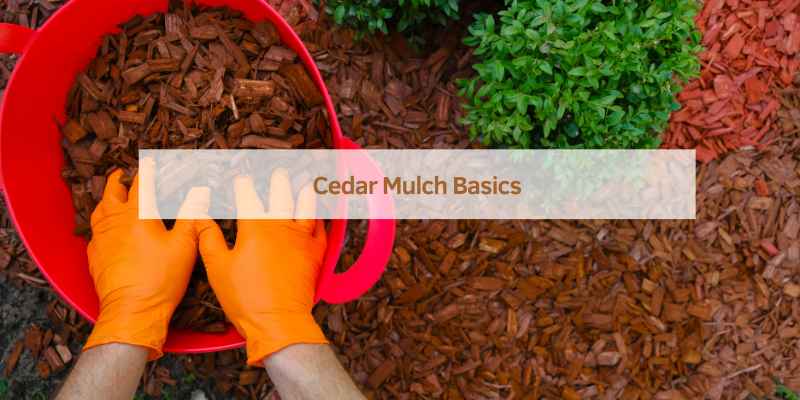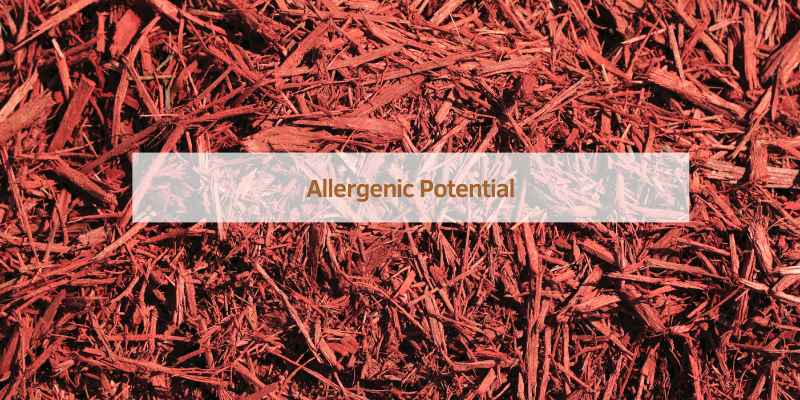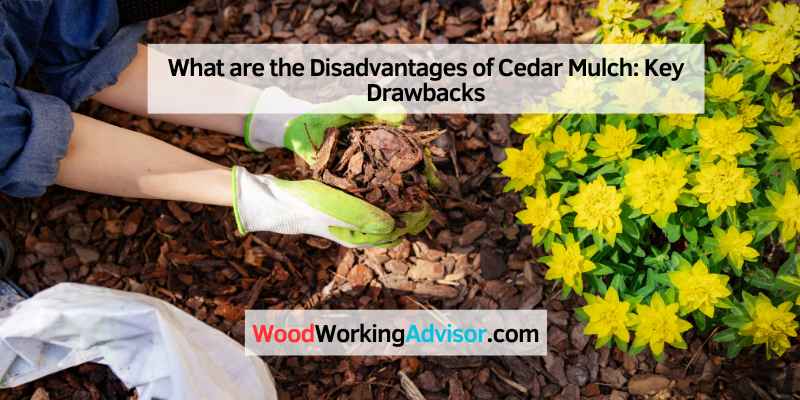Cedar mulch can be expensive and may repel beneficial insects. It also decomposes slowly, affecting soil nutrient levels.
Cedar mulch is popular for its durability and pleasant aroma. Gardeners appreciate its ability to suppress weeds and retain soil moisture. Despite these benefits, it’s important to consider the disadvantages. Cedar mulch can be pricey, making it less accessible for budget-conscious gardeners.
It also emits natural oils that may repel beneficial insects, which are crucial for a healthy ecosystem. Additionally, cedar mulch decomposes slowly, potentially limiting the nutrients released into the soil. This slow decomposition can affect plant growth over time. Understanding these drawbacks helps gardeners make informed choices about their mulch options.
Cedar Mulch Basics
Cedar mulch is made from cedar trees. It has a pleasant smell. There are two main types of cedar mulch: shredded and chip. Shredded cedar mulch looks like thin strips. Chip cedar mulch looks like small pieces. Both types decompose slowly.
Cedar mulch is often used in gardens and flower beds. It helps keep moisture in the soil. It also helps control weeds. Cedar mulch can protect plants from extreme temperatures. Many people like its natural look.

Aesthetic Concerns
Cedar mulch starts with a bright color. Over time, it loses its vibrant look. The mulch turns gray or silver. This may not be appealing to everyone.
Cedar mulch pieces are not always the same size. This can make gardens look messy. The texture can be uneven. Some parts may appear more clumped than others.
Cost Implications
Cedar mulch can be more expensive than other mulch options, leading to higher landscaping costs. Its price might deter budget-conscious gardeners.
Higher Price Point
Cedar mulch often costs more than other mulches. The high cost can strain your budget. This mulch is not always easy to find. The price might increase if demand is high. People may need to pay extra for delivery. The higher cost can make it less appealing. Families on a tight budget might avoid it. Choosing cedar mulch can mean spending more money.
Frequency Of Replacement
Cedar mulch breaks down slowly. This can be good, but it also means it needs replacing. Mulch that breaks down too quickly needs frequent replacement. Frequent replacement can be costly. The mulch might need topping up each year. This increases the overall cost. People may not want to replace it often. The need for more mulch can add up over time.
Environmental Impact
Cedar mulch can release natural toxins, harming sensitive plants. It may also attract unwanted pests and require frequent replenishment.
Source Sustainability
Cedar mulch is often sourced from natural forests. This can lead to deforestation and loss of trees. The demand for cedar mulch can affect the balance of local ecosystems. Harvesting cedar trees may not be sustainable in the long run. Sustainable practices should be prioritized for future generations.
Wildlife Disruption
Removing trees for cedar mulch can disrupt wildlife habitats. Animals rely on trees for shelter and food. Birds, insects, and small mammals are affected the most. Disruption can lead to a decline in local biodiversity. Ensuring minimal disruption to wildlife is important.
Plant Health Risks
Cedar mulch can deplete the soil of nitrogen. Plants need nitrogen to grow well. Without enough nitrogen, plants may turn yellow. They may also grow slowly and weakly. Gardeners might need to add extra fertilizer. This can be extra work and cost more money.
Cedar mulch can hold a lot of moisture. This moisture can lead to fungal growth. Fungi can harm plant roots. They can also spread diseases to other plants. Keeping mulch too wet can make this problem worse. Always keep an eye on the moisture level.
Maintenance Challenges
Cedar mulch can be hard to remove. It sticks together and forms a dense layer. This makes it difficult to pull out. It can also break into small pieces. These pieces are hard to collect. Removing cedar mulch is time-consuming and labor-intensive. It may require special tools. The roots of plants can also get tangled in the mulch. This makes removal even more difficult.
Cedar mulch decomposes very slowly. This means it stays on the ground for a long time. Slow decomposition can affect soil health. It may prevent water and nutrients from reaching plant roots. Decomposing mulch can also attract pests. This can be harmful to plants. The long-lasting nature of cedar mulch is a double-edged sword.
Pest Attraction Issues
Cedar mulch can attract termites and other insects. These pests can damage wooden structures. Your home may be at risk. Insects can find shelter in the mulch. This can lead to infestations. Termites are a major concern. They can cause extensive damage to homes. Regular monitoring is essential. Mulch should be kept away from the house foundation.
Rodents like to nest in cedar mulch. This can lead to more rodents around your home. Mice and rats can carry diseases. They may also chew on wires and wood. This can cause safety hazards. Regularly check for rodent activity. Keeping mulch layers thin can help. Using alternative mulches may reduce these risks.
Chemical Considerations
Cedar mulch contains natural oils and toxins. These can sometimes harm plants. Sensitive plants may struggle to grow. The oils can seep into the soil. This affects the plants’ roots. Some plants might even die. It is important to check plant types before using cedar mulch. Not all plants will react the same way.
Sensitive plants can suffer from cedar mulch. The natural oils can cause issues. Roots may not absorb nutrients well. Stunted growth is a common problem. Some plants may change color. Leaves could turn yellow or brown. This is a sign of stress. Always monitor plants after applying cedar mulch.
Water Management
Cedar mulch can lead to poor soil aeration and water retention. Its natural oils may also inhibit plant growth.
Water Repellency
Cedar mulch can be water-repellent. Water may not soak through easily. This can harm plants that need lots of water. Dry soil can stress plants. It may also cause roots to dry out.
Drainage And Moisture Concerns
Poor drainage is a problem with cedar mulch. Water can stay on top of the mulch. This stops it from reaching the soil. Plants may not get enough water. Too much moisture on top can cause mold. Mold can harm plant health.
Allergenic Potential
Cedar mulch can cause allergic reactions in some people. Touching or breathing in the mulch can trigger skin rashes. Some might experience sneezing and itchy eyes. These reactions can be uncomfortable and persistent.
Cedar mulch can be a respiratory irritant. Inhaling the dust from cedar mulch can irritate the lungs. This can lead to coughing and wheezing. Those with asthma or other lung issues might find it harder to breathe.

Frequently Asked Questions
When Should You Not Use Cedar Mulch?
Avoid using cedar mulch in vegetable gardens. It may inhibit plant growth. Cedar mulch is also unsuitable for areas with poor drainage.
What Bugs Does Cedar Mulch Repel?
Cedar mulch repels ants, termites, roaches, moths, and certain beetles. Its natural oils deter these pests effectively.
Does Cedar Mulch Attract Termites?
Cedar mulch generally repels termites due to its natural oils. It is less likely to attract termites compared to other mulches.
What Plants Like Cedar Mulch?
Many plants thrive with cedar mulch, including roses, azaleas, rhododendrons, and gardenias. Cedar mulch helps retain moisture and suppress weeds, benefiting these plants.
Conclusion
Cedar mulch has its drawbacks. It can be expensive and may attract pests. The mulch might also affect soil pH. Consider these factors before choosing cedar mulch for your garden. Weigh the pros and cons to make an informed decision.
Ultimately, choosing the right mulch enhances your gardening success.


